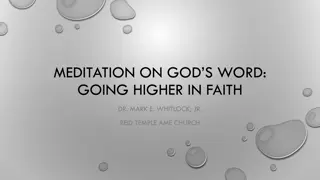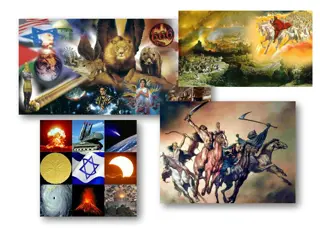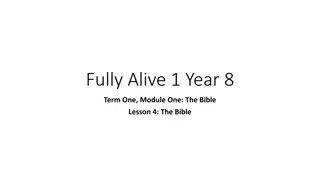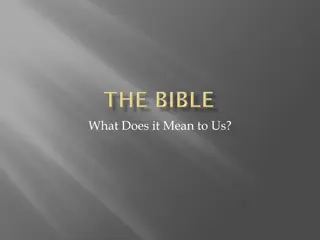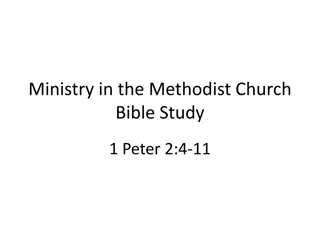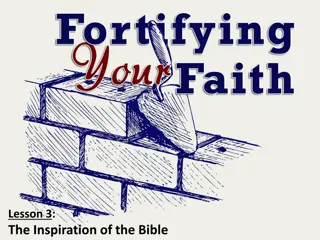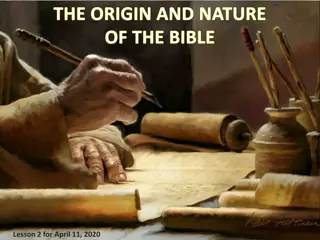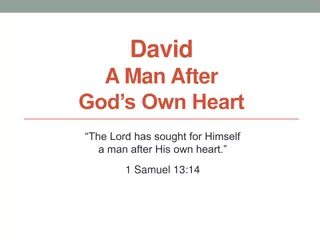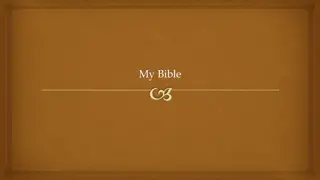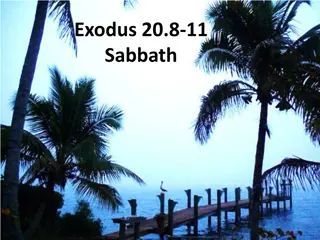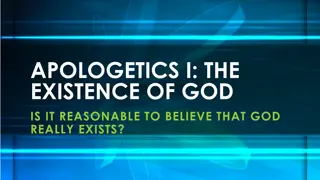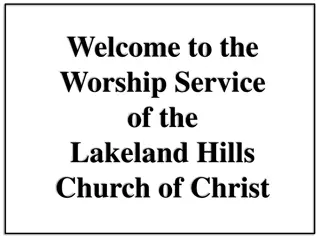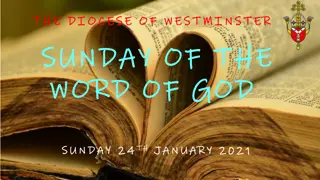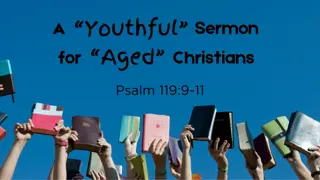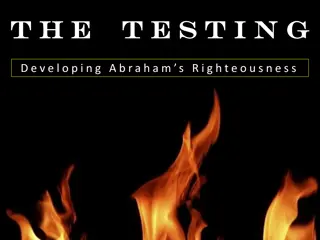Understanding How the Bible Came from God
The Bible is seen as a revelation from God to humanity, with various forms of communication indicating divine influence, including through scripture, nature, creation, human consciousness, historical events, the words of prophets, and ultimately through the person of Jesus Christ. This collection of divine revelations showcases the belief that the Bible is a product of God's communication and guidance to mankind throughout history.
Download Presentation

Please find below an Image/Link to download the presentation.
The content on the website is provided AS IS for your information and personal use only. It may not be sold, licensed, or shared on other websites without obtaining consent from the author. Download presentation by click this link. If you encounter any issues during the download, it is possible that the publisher has removed the file from their server.
E N D
Presentation Transcript
THE BIBLE CAME FROM GOD how did we get the bible
1. REVELATION OF SCRIPTURE God communicating to man what He wants us to know (Hebrews 1:1)
REVELATION God reveals himself through Nature & Creation Romans 1:19-20 (NLT) 19 They know the truth about God because he has made it obvious to them. 20 For ever since the world was created, people have seen the earth and sky. Through everything God made, they can clearly see his invisible qualities his eternal power and divine nature. So they have no excuse for not knowing God.
TEXT God Reveals himself in the Conscious of Man Romans 1:19-20 (NLT) 19 They know the truth about God because he has made it obvious to them. 20 For ever since the world was created, people have seen the earth and sky. Through everything God made, they can clearly see his invisible qualities his eternal power and divine nature. So they have no excuse for not knowing God.
REVELATION God reveals himself through History Ezekiel 20:4-7 (NLT) 4 Son of man, bring charges against them and condemn them. Make them realize how detestable the sins of their ancestors really were. 5 Give them this message from the Sovereign LORD: When I chose Israel when I revealed myself to the descendants of Jacob in Egypt I took a solemn oath that I, the LORD, would be their God.
TEXT 6 I took a solemn oath that day that I would bring them out of Egypt to a land I had discovered and explored for them a good land, a land flowing with milk and honey, the best of all lands anywhere. 7 Then I said to them, Each of you, get rid of the vile images you are so obsessed with. Do not defile yourselves with the idols of Egypt, for I am the LORD your God.
REVELATION God reveals himself through Words of the Prophets Hebrews 1:1 (NASB) 1 God, after He spoke long ago to the fathers in the prophets in many portions and in many ways,
REVELATION Person of Jesus Christ Hebrews 1:2 (NLT) 2 And now in these final days, he has spoken to us through his Son. God promised everything to the Son as an inheritance, and through the Son he created the universe.
2 KINDS OF revelation
2 KINDS OF REVELATION general revelation is truth that God makes known or available to everyone regardless of their beliefs and acknowledgments. Romans 1:19-20 (NLT) 19 They know the truth about God because he has made it obvious to them. 20 For ever since the world was created, people have seen the earth and sky. Through everything God made, they can clearly see his invisible qualities his eternal power and divine nature. So they have no excuse for not knowing God.
2 KINDS OF REVELATION Specific Revelation Is Truth that God imparts to a specific person or group of People. 1 Corinthians 2:13-15 (NLT) 13 When we tell you these things, we do not use words that come from human wisdom. Instead, we speak words given to us by the Spirit, using the Spirit s words to explain spiritual truths. 14 But people who aren t spiritual can t receive these truths from God s Spirit. It all sounds foolish to them and they can t understand it, for only those who are spiritual can understand what the Spirit means. 15 Those who are spiritual can evaluate all things, but they themselves cannot be evaluated by others.
2. 2. INSPIRATION OF SCRIPTURE God superintending human writers to compose and record His revelation to mankind 2 Timothy 3:16;2 Peter 1:21
INSPIRATION OF SCRIPTURE WHAT IS INSPIRATION? THE PROCESS WHERE THE HOLY SPIRIT GUIDES MEN AS THEY RECORD THE REVEALED WORD OF GOD WORD FOR WORD AND WITHOUT ERROR.
INSPIRATION OF SCRIPTURE 3 THEORIES OF INSPIRATION 1. Natural Theory- the Bible authors were inspired the same way William Shakespeare was inspired. 2.Content Theory- God merely gave man the main content or idea, allowing him to choose his own words to express that concept. 3.Plenary-Verbal- ALL (plenary) the very words (verbal) of the Bible are inspired by God.
2 Timothy 3:16 (NASB) 16 All Scripture is inspired by God and profitable for teaching, for reproof, for correction, for training in righteousness; 2 Timothy 3:16 (NIV) 16 All Scripture is God-breathed and is useful for teaching, rebuking, correcting and training in righteousness,
INSPIRATION OF SCRIPTURE MEANS INSPIRATION THEOPNEUSTOS GOD-BREATHED 2 Timothy 3:16
Exodus 24:4 (ESV) 4 And Moses wrote down all the words of the LORD. He rose early in the morning and built an altar at the foot of the mountain, and twelve pillars, according to the twelve tribes of Israel.
Deuteronomy 31:9 (NLT) 9 So Moses wrote this entire body of instruction in a book and gave it to the priests, who carried the Ark of the LORD s Covenant, and to the elders of Israel.
2 Peter 1:20-21 (NIV) 20 Above all, you must understand that no prophecy of Scripture came about by the prophet's own interpretation. 21 For prophecy never had its origin in the will of man, but men spoke from God as they were carried along by the Holy Spirit.
how we got the bible GOD SPOKE IT MEN WROTE IT HOLY SPIRIT MADE SURE OF IT Process of Inspiration
3. TRANSMISSION OF THE SCRIPTURE The ancient process of accurately copying Hebrew and Greek scriptures for successive generations
TRANSMISSION OF THE SCRIPTURE Transmission - The ancient process of accurately copying Hebrew and Greek scriptures for successive generations
TRANSMISSION OF SCRIPTURE TRANSMISSION The original writings are copied and circulated so that by approximately AD 150 there is wide enough use of them to speak of the New Testament ( New Covenant ).
SCRIBES Priest whose function was make copies of biblical text and teaching people the law
Ezra 7:6 (NIV) 6 this Ezra came up from Babylon. He was a teacher well versed in the Law of Moses, which the LORD, the God of Israel, had given. The king had granted him everything he asked, for the hand of the LORD his God was on him.
Ezra 7:9-11 (NIV) 9 He had begun his journey from Babylon on the first day of the first month, and he arrived in Jerusalem on the first day of the fifth month, for the gracious hand of his God was on him. 10 For Ezra had devoted himself to the study and observance of the Law of the LORD, and to teaching its decrees and laws in Israel.
11 This is a copy of the letter King Artaxerxes had given to Ezra the priest and teacher, a man learned in matters concerning the commands and decrees of the LORD for Israel:
Romans 3:2 (NIV) 2 Much in every way! First of all, they have been entrusted with the very words of God.
Ezra the scribe According to Jewish tradition, Ezra, a priest and scribe, collects and arranges some of the books of the Hebrew Bible, around 450 BC.
Masoretes Special Jewish scribes (Masoretes) are entrusted with the sacred task of making copies of the Hebrew Scriptures (Old Testament).
TRANSMISSION OF SCRIPTURE Masoretes The Masoretes developed a meticulous system of counting the number of words in each book of the Bible to make sure it was copied accurately. Any scroll found to have an error is buried according to Jewish law.
TRANSMISSION OF SCRIPTURE Masoretic process 1.They could only use clean animal skins, both to write on, and even to bind manuscripts. 2.Each column of writing could have no less than forty-eight, and no more than sixty lines.
TRANSMISSION OF SCRIPTURE Masoretic process 3. The ink must be black, and of a special recipe. 4. They must verbalize each word aloud while they were writing.
TRANSMISSION OF SCRIPTURE Masoretic process 5. They must wipe the pen and wash their entire bodies before writing the word Jehovah, every time they wrote it. 6. There must be a review within thirty days, and if as many as three pages required corrections, the entire manuscript had to be redone.
TRANSMISSION OF SCRIPTURE Masoretic process 7.The letters, words, and paragraphs had to be counted, and the document became invalid if two letters touched each other. The middle paragraph, word and letter must correspond to those of the original document. 8.The documents could be stored only in sacred places (synagogues, etc).
Masoretic process 9.As no document containing God s Word could be destroyed, they were stored, or buried, in a genizah a Hebrew term meaning hiding place. These were usually kept in a synagogue or sometimes in a Jewish cemetery.
4. CANON OF SCRIPTURE God guiding the early church to recognize what books are inspired
canon God guiding the early church to recognize what books are inspired
cANON 1. Comes from Greek word meaning measuring rod 2. Refers to books of the Bible that have accepted as having divine authority in the church.
Canon As the new testament church grew so did the prospect of sacred writings. There was a need to determine which writing were divinely inspired from those that were not
4 criteria for scriture 1.Apostolic Origin attributed to and/or based on the preaching/teaching of the first- generation apostles (or their closest companions). 2.Universal Acceptance acknowledged by all major Christian communities in the Mediterranean world (by the end of the fourth century).
4 criteria for scriture 3. Liturgical Use read publicly along with the OT when early Christians gathered for the Lord's Supper (their weekly worship services). 4.Consistent Message containing theological ideas compatible with other accepted Christian writings (incl. the divinity and humanity Jesus).
canon 5. Historical Evidence 6. Manuscript Evidence 7. Archeological Evidence 8. Evidence of Messianic Prophecies


 undefined
undefined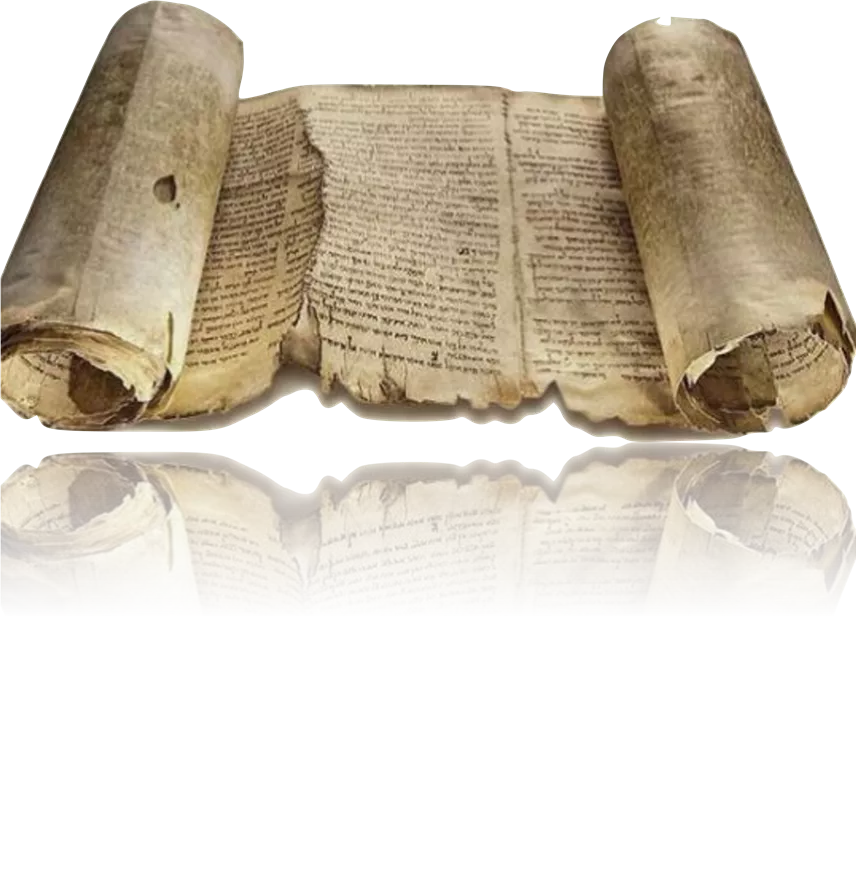

 undefined
undefined


